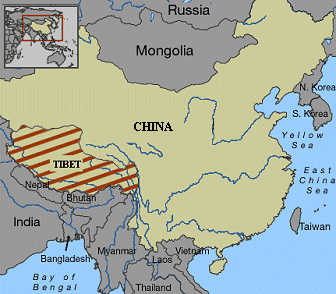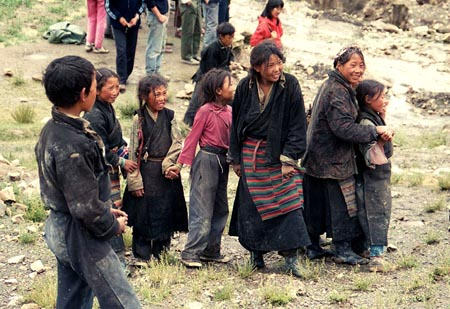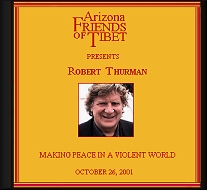Tibet: An Endangered Land
and People
 Tibet
was a sovereign nation
for two thousand years, inhabited by six million people sharing a distinct
language, culture and history. In 1950, the People's Republic of China
invaded and occupied Tibet in violation of international treaties and
laws. His Holiness the Dalai Lama, Tibet's head of state and spiritual
leader, tried for eight years to resolve the situation through dialogue
and persuasion, until 1959 when a Tibetan uprising was brutally crushed
by the communist Chinese. The Dalai Lama fled to India with his government
and tens of thousands of Tibetan citizens.
Tibet
was a sovereign nation
for two thousand years, inhabited by six million people sharing a distinct
language, culture and history. In 1950, the People's Republic of China
invaded and occupied Tibet in violation of international treaties and
laws. His Holiness the Dalai Lama, Tibet's head of state and spiritual
leader, tried for eight years to resolve the situation through dialogue
and persuasion, until 1959 when a Tibetan uprising was brutally crushed
by the communist Chinese. The Dalai Lama fled to India with his government
and tens of thousands of Tibetan citizens.
Granted asylum by the Indian
government, the Dalai Lama established the Tibetan government-in-exile
in Dharamsala, which continues to help Tibetan refugees and to work
for a non-violent end to Chinese occupation of Tibet.

 Current
Situation - The current situation in Tibet remains tense. Under Chinese
occupation, human rights abuses, religious repression and environmental
destruction are everyday occurrences. The policy of population transfer,
which encourages Han Chinese to settle in Tibetan areas, threatens to
destroy the unique Tibetan culture and way of life.
Current
Situation - The current situation in Tibet remains tense. Under Chinese
occupation, human rights abuses, religious repression and environmental
destruction are everyday occurrences. The policy of population transfer,
which encourages Han Chinese to settle in Tibetan areas, threatens to
destroy the unique Tibetan culture and way of life.
Key Issues

Invasion &
Repression - Tibet was as an independent country in control of all
its foreign, military and domestic affairs prior to China's invasion.
Since that time, more than 1.2 million Tibetans - one sixth of the population
- have died as a direct result of Chinese occupation. Tibet now accounts
for one quarter of China's land mass. China continues its authoritarian,
oppressive rule over Tibet, denying the Tibetan people their fundamental
human, social, political, economic, and religious rights.
Human Rights
Abuses - Tibetans have no freedom of speech or assembly, no political
autonomy, no access to self-determination, little religious freedom
and there are ever-increasing accounts of arbitrary arrests, political
imprisonment and torture. Currently, hundreds of Tibetans are held as
political prisoners in jails and labor camps across Tibet. Documented
methods of torture include beatings with chains and sticks with protruding
nails, iron bars, shocks with electric cattle prods, hanging by the
arms twisted behind the back, and exposure to extreme temperatures.

Religious Oppression
- In 1997 Chinese leaders labeled Buddhism a "foreign culture."
Tibetan Buddhism is subject to intense scrutiny and control by local
government, police and Party bodies. Monks and nuns are asked to denounce
the Dalai Lama, and his photos are banned. Arrest and imprisonment are
common occurrences for maintaining ties or loyalty with the Dalai Lama.
Monks and nuns account for the majority of prisoners incarcerated in
Tibet and include 12 year old Gedhun Choekyi Nyima, recognized by the
Dalai Lama as the incarnation of the Panchen Lama.
Cultural Destruction
- Since the Chinese invasion more than 6,000 monasteries have been destroyed,
with less than 40 standing today. Many religious artifacts and cultural
icons have been looted and destroyed while most of Tibet's traditional
literature has been eradicated. Chinese is taught as the first language
in Tibetan schools and is required for most employment and higher education
opportunities. In Lhasa, many Tibetan houses and entire neighborhoods
have been demolished making way for Chinese development.

Environmental
Damage - The preservation of Tibet's environment is critical to
Asia's natural resources and wildlife. Under Chinese occupation, Tibet
has suffered severe clear-cutting of its forests, strip-mining of its
mineral and uranium deposits, damming of its major rivers and dumping
of toxic and nuclear wastes across the plateau. Tibet is the largest
timber reserve at the disposal of China. Today, barely half of Tibet's
ancient forests remain. It is widely held that such deforestation is
responsible for the destructive floods that recently swept through China,
India and South East Asia.
Population Transfer
& Birth Control Policy - Deliberate population transfer policies
have been introduced in Tibet to dilute and assimilate Tibetan language
and culture. Chinese workers are offered wage incentives, better living
conditions and employment, and exemptions from China's strict "one-child"
policy. Tibetans now make up less than half the population. Tibetan
women must seek permission from authorities before becoming pregnant
or risk severe penalties including forced sterilization and abortion,
or economic sanctions as great as three times their annual income. Tibetans
are a minority in their own country.

back to
top
GET INVOLVED: WHAT YOU
CAN DO
 Take
Action Now to Help Free Tibet
Take
Action Now to Help Free Tibet
For thousands of
years human beings have used the teachings of nonviolence not only as
a guideline for spiritual and ethical behavior, but as a message for
social change. The courageous principles demonstrated by figures like
Thoreau, King, Gandhi, and the Dalai Lama stand as an example for all
of us. Throughout history, people like these have refused to take up
arms in their struggles and have insisted that all their actions be
motivated by compassion and love.
Throughout the
course of the Chinese occupation, hundreds of thousands of Tibetans
have been imprisoned or killed by Chinese police. The Dalai Lama emphasizes
love and compassion, and continues to regard the Chinese as his greatest
teachers. As he says: "For a person who cherishes compassion and
love, the practice of tolerance is essential; and for that, an enemy
is indispensable."
Since 1959, The
Tibetan people have maintained a nonviolent struggle against the Chinese
government's brutal occupation. They have lobbied, demonstrated, and
gone on hunger strikes to further their cause for freedom. In keeping
with traditional Buddhist thought, the Dalai Lama and the Tibetan government-in-exile
in Daramasala act and govern with the benefit of all beings in mind,
including the Chinese.
Why Tibet? The
integrity of the Dalai Lama and the Tibetan people stand as models for
us all. The struggle of the Tibetan people has been non-violent for
over forty years and their courage in the face of sustained persecution,
brutality and world-wide apathy truly deserves the support of those
with the freedom to do so.
 What
You Can Do
What
You Can Do
Use your voice
to demand change for the things you care about. Whether you send e-mail
to your Senator, vote in an election, support Tibetan organizations,
boycott Chinese goods, or talk to your children about human rights,
you are making a difference. Use the tools we have provided to make
it easier to get involved.
Support
Arizona Friends of Tibet (click here)
 How
to be Heard
How
to be Heard
Telephone,
Telefax, or e-Mail? A handwritten or typed letter carries the most
weight with any recipient. A telephone call shows that you care enough
to spend a little money, and if you can actually speak with the recipient,
phone conversations offer unparalleled opportunity for feedback. E-mails
require less commitment from the sender. Recipients, of course, have
this in mind when they read emails. However, the convenience - not
to mention the potential to mobilize hundreds or even thousands of
messages - makes email an indispensable tool.
Writing
to Elected Officials
It
is important that we tell elected officials where we stand on issues.
Our input on clean water, sprawl, trade, and other issues shapes the
way our representatives create and implement environmental and social
policy.
E-mails,
postcards, and phone calls are good communication tools, but letters
and faxes are the most effective and persuasive way of communicating
our views to elected officials.
A
Better Letter to the Editor
Letters
to the Editor are one of the most widely read sections of the newspaper
and reach a large audience. They allow community members to comment
on the way issues are being addressed in the media and to influence
what topics the local paper covers. Elected officials often monitor
this section of the newspaper and take notice of constituents' opinions.
Due
to strict space limitations in newspapers, not all letters will be published,
but the more letters the newspaper receives on a certain topic, the
more likely they are to run at least one letter on the topic. Check
the letter guidelines in your local paper and use these tips to write
an effective letter to the editor:
Keep
it short and focused. Many newspapers have strict length limits and
edit letters for space. A concise, single-issue letter has a better
chance of retaining its salient points and keeping the reader's interest.
Make specific references.
While some newspapers will print general commentary letters, most prefer
letters that respond to a specific article. Here are some ways to refer
to an article:
I was impressed
by the comprehensive logging solution outlined in the May 5th article,
"Sustainable Logging on a Roll."
I strongly disagree
with Senator Baker's position against increased fuel economy standards
("To be or SUV," June 22).
Be
factual and highlight aspects of the issue that haven't been previously
addressed.
Include
your contact information. Many newspapers will only publish a letter
to the editor after verifying the author's contact information. When
printed, the letter will usually only include your name and city.
Type
and sign letter.
Send
letters to smaller newspapers. Small newspapers are more likely to print
your letter and the letter can then spark local community action.
Now's
Your Chance: Meeting with elected officials
Meeting
with elected officials in person is an opportunity to make personal
contact with decision-makers and convey your position in a persuasive
and animated manner. A lobby visit allows you to tell your Senator or
Representative what you think about a certain issue or bill and ask
her/him to take positive action.
Get
Connected! Contact information
- Phone Your
Senator or Representative
by calling the US Capitol Switchboard at 202-224-3121
Write Your Senator at: US Senate, Washington, DC 20510
Web: http://www.senate.gov/
- Write Your
Representative
US House of Representatives, Washington, DC 20515
Web: http://www.house.gov/
- Contact the
President
The White House 1600 Pennsylvania Avenue NW, Washington, DC 20500
Tel: 202-456-1111 ~ Fax: 202-456-2461
~ e-mail: [email protected]
Suggestions
for a successful lobby visit:
Before the meeting:
Request a meeting in writing with specific times and dates. Follow
up with a call to the scheduler or secretary to confirm the meeting.
Make sure to convey what issue or bill you would like to discuss. Decide
on talking points to express your most important ideas. Set a goal for
the meeting. Do you want the Representative to vote for or against a
bill or introduce legislation?
During the meeting:
Be prompt. Keep it short and stick to your talking points. Take the
time to thank the elected official for past votes in support of your
issues. Provide personal and local examples of the impact of the legislation.
Be honest and don't claim to know more than you do about an issue. You
don't have to be the expert, just a committed and active constituent.
Set a deadline or timeline for response.
After the meeting:
Write a thank you letter to the legislator. Send any materials and
information you offered. Follow up on deadlines and if they are not
met, set up others. Be persistent.
back to
top
Support
Arizona Friends of Tibet (click here)



































 Dalai
Lama on Confronting Problems
Dalai
Lama on Confronting Problems
